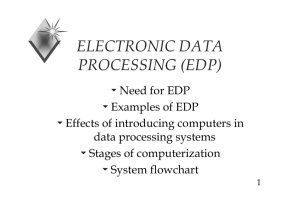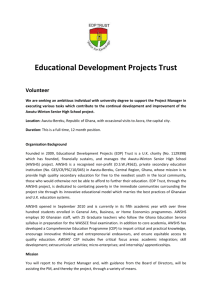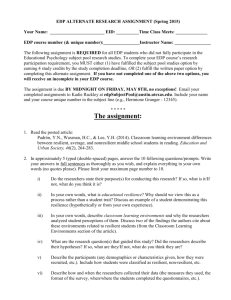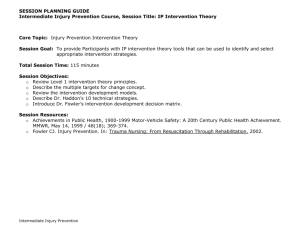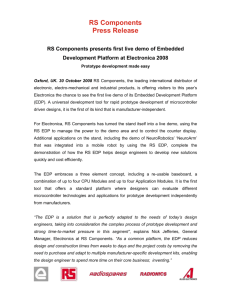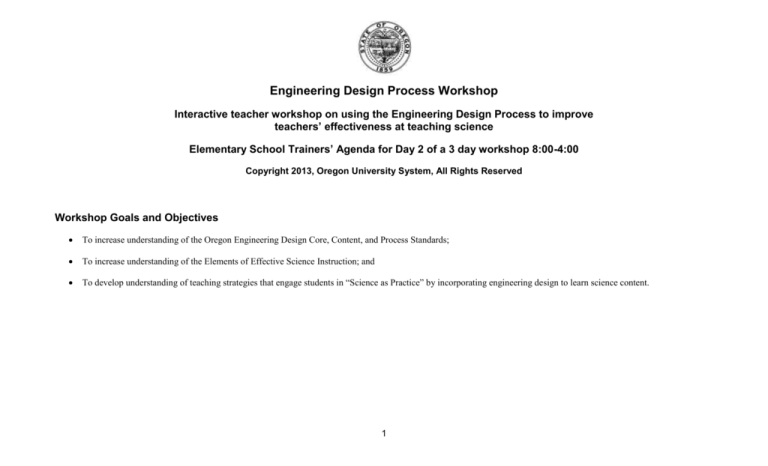
Engineering Design Process Workshop
Interactive teacher workshop on using the Engineering Design Process to improve
teachers’ effectiveness at teaching science
Elementary School Trainers’ Agenda for Day 2 of a 3 day workshop 8:00-4:00
Copyright 2013, Oregon University System, All Rights Reserved
Workshop Goals and Objectives
To increase understanding of the Oregon Engineering Design Core, Content, and Process Standards;
To increase understanding of the Elements of Effective Science Instruction; and
To develop understanding of teaching strategies that engage students in “Science as Practice” by incorporating engineering design to learn science content.
1
Day Two – Elementary School
Time
Total: 5 min
8:00-8:05:
Welcome
(5 min)
Activity
Unit One – Welcome Back and Overview
Facilitator Notes
Lead
1)
Welcome participants to the EDP PD.
Introductions – Facilitators/Participants
Workshop Goals (on slide and poster)
Logistics – description of baskets
Expectations (Hopes)
Bike Rack
Credit Information
Workshop and Folder Overview
Group Norms
Day 2 Agenda review (slide)
Materials
Main Room:
Laptop Computer
LCD Projector
EDP Facilitator’s Folder
Before Session:
Hang standards posters,
set out participant folders,
& baskets
Participant Folder:
Agenda
Post Workshop Goals &
Agenda written on poster
Training Kit:
PPT
Agenda
Post Bike Rack,
Expectations, and Group
Agreements charts
Supplies:
EDP Posters
Agenda
Folders
Sign-in Roster
Name Tags
Markers & Chart pack
Baskets with
highlighters
post it notes
toys
A Brick for a Pig Full Lesson
Plan
Joanie Appleseed Full
Lesson Plan
Posters:
Goals
Agenda
Bike Rack (by coffee)
Expectations
Group Agreements/Norms
Standards
2
Set-up
Sign in & Name Tags out
Set up a laptop in main
room with a timer.
Time
Total: 55 min –
8:05-9:00
Activity
How the engineering-design process applies to
teaching and learning science in elementary
school
8:05-9:00
Engineering Design
Standards in
elementary school
posters and
carousel
(25 min)
Total :45 min –
9:00-9:45
9:00-9:25
Brainstorm, build,
and test an index
card chair
(20 min)
9:25-9:45
Sharing and
Cleanup (20 min)
Index Card Chair Activity
Lead
Materials
Facilitator Notes
Engineering Design Standards in
Elementary School
1) Group participants by grade.
2) Have each group choose a strip of
paper out of the bowl.( 5 min)
3) As a group, participants will draw or
sketch a representation of the Core
and Content Standards that go along
with the grade level they selected (15
minutes).
4) When each group has finished
creating their picture or series of
pictures, have them complete a Core
and Content Standards Tour or
carousel.
5) Each small group will rotate to the 5
other stations (5 minutes each).
6) At each station, participants will
review the Core and Content
Standards for each grade level.
7) Rotating groups will provide feedback
with sticky notes.
8) Groups review feedback (5 minutes).
9) Show the Slide, “Comparing the
Process for Grades 1-3 and 4-5” to
have a quick reference on the
engineering design process. For
more detailed descriptions of the
process, review the Elementary
School Primer.
Index Card chair Activity
1) Tell participants that they’ll be
working in pairs to design a chair that
can support the weight of a can out of
index cards.
2) Hand out the Index Card Chair
Challenge Sheet.
3) Have participants brainstorm two
chair designs.
4) Keep the participants on time. Give a
few minutes of warning when the
activity is about to end.
3
Essential Skills
Science Inquiry and the EDP
Participant Folder:
Loose blank paper
K-5 ED Core and Content
Standards
EDP Process for Grades 1-3
and 4-5
Training Kit:
PPT
Supplies:
Strips of paper with
Kindergarten, 1st Grade, 2nd
Grade, 3rd Grade, 4th
Grade, and 5th Grade
Pencils and Markers
bowl for paper strips
Tape
Chart Packs
Participant Folder:
Comparing the Process for
Grades 1-3 and 4-5
EDP Process for Grades 1-3
and 4-5
Training Kit:
PPT
Supplies:
Set-up
Time
Activity
Facilitator Notes
Lead
5)
6)
7)
8)
9:45-10:00
Break
(15 min)
Total: 105 min
10:00 – 10:40
Presenting and
Completing the
lesson (40 min)
10:40-11:00
Sharing and
Cleanup (20 min)
11:00-11:25
Scientific Inquiry vs
the EDP (25 min)
11:25-11:45 Small
Group Discussion
(20 min)
BREAK
Unit 2 – A Brick for a Pig
Hands-on exercise featuring the Engineering
Design process for learning Earth and Space
Science
1)
2)
3)
4)
5)
6)
7)
8)
Materials
After the participants have built their
chair, line the chairs up side by side
on a table and see which chairs can
hold the designated object.
Divide participants into grades K-3
and 4-5.
Have participants reflect on designing
their chair and share what they feel
students should learn about the
engineering design process.
Have participants create a list on
chart packs and share out
Participants take a break
Index Cards (6/group)
Scissors
Masking Tape
Pencils and Markers
unopened can
Chart Packs
Have participants read the handouts and
make their bricks.
Locate your pre-made bricks and have the
participants gather around with their Bricks
for Pigs Design Handout. Make sure
everyone can see.
Conduct your demonstration of assessing
the brick strength and have participants
complete their handout.
Have participants share what they have
learned. Ask about things they will have
noticed or had difficulty with
Summarize main idea on chart pack
Group Discussion: Scientific Inquiry vs.
the Engineering Design Process. Groups
use flip charts to answer 3 questions
Summarize the project, and reflect on the
discussion questions as well as the
overarching messages about using the
engineering design process to improve the
teaching of science
Small group discussion on implementing
the EDP into their lesson plans or grade
band level.
Participant Folder:
A Brick for a Pig Handouts
4
Training Kit:
PPT
Pre-made bricks
Supplies per group of 3
Dixie cup of water
Dixie cup of glue
3 empty Dixie cups that have
been sprayed with non-stick
a marker
a plastic spoon
a mixing container
Sand
Aquarium Gravel
River pebbles
Extra Dixie or small cups
Non Stick Spray
Watering Can
Washers
White glue
Set-up
Make sample bricks at least 3 days
before the workshop. These will be
used as demonstration bricks
because the workshop does not
allow enough time for the
participant’s bricks to harden. The
drying process takes 3 days so
data is included in the activity for
further discussion.
Line out your brick materials in
bags or bowls along a table or
counter. Have two or more empty
Dixie cups next to each material for
measuring.
You may want to cover the tables
with protective paper in case of
spills.
Place paper towels and sponges
around the room in case of spills.
Time
Activity
Materials
Facilitator Notes
Lead
Set-up
Containers for Mixing
Ingredients
Trays for testing
Protective Paper, paper
towels and sponges for easy
cleanup (optional)
Total 45 min
LUNCH
11:45 – 12:30
Total: 90 min
12:30- 2:00
Individual Reflection or Team Planning Time
12:30 – 1:05
Presenting and
Completing the
lesson (35 min)
1:05-1:25 Sharing
and Cleanup (20
min)
Unit 3 – Hand Pollinator
Hands-on exercise featuring the Engineering
Design process for learning Life Science
In groups of 2 have participants use the
engineering design process to design a
hand pollinator.
9)
10)
11)
1:25-1:50 Scientific
Inquiry vs the EDP
(25 min)
12)
13)
1:50-2:00 Small
Group Discussion
(10 min)
14)
15)
Have participants read the Hand Pollinator
Article, sketch three designs and make
their pollinators.
Pass out the apple trees to each table and
have groups pollinate the trees.
Have participants share what they have
learned. Ask about things they will have
noticed or had difficulty with
Summarize main ideas on chart pack
Group Discussion: Scientific Inquiry vs.
the Engineering Design Process. Groups
use flip charts to answer 3 questions
Summarize the project, and reflect on the
discussion questions as well as the
overarching messages about using the
engineering design process to improve the
teaching of science.
Small group discussion on implementing
the EDP into their lesson plans or grade
band level.
5
Participant Folder:
Hand Pollinator Article
Hand Pollinator Engineering
Worksheet
Pollen Counting Sheet
Training Kit:
PPT
Supplies:
Pom poms
Eraser caps
Wooden sticks
Flexible straws
Coffee stir straws
Pipe cleaners
Sponges
Feather
Clay
Cotton balls
Hand Pollinator Test Kit (glue
stick, scissors, small dish or cup
of glitter)
Paper towel rolls
Dixie cups
Fake Flower Apple Blossoms
Plan to have participants work in
pairs. Arrange 2-3 pairs, or as
many as will share a model apple
tree at each table or work station.
Make the apple trees by cutting
three slots into the bottom of a
paper towel roll. Fold the flaps to
the outside and tape them down on
a table or counter surface. This is
the trunk of the tree. Put one or
two stems of apple blossoms into
each trunk.
Line out your hand pollinator
materials in bags or bowls along a
table or counter. Include with the
materials, as many kinds of tape as
you have available for participants
to use such as scotch, masking,
and duct tape.
Cut-out the bottom of a Dixie cup
for each group or pair.
Prepare kits of the following for
each group: glue stick, scissors,
small dish or cup of glitter. See
activity for full write-up.
Time
1:45-2:00
Activity
Lead
Facilitator Notes
Troubleshooting as an opportunity for learning
science
Short presentation followed by discussion
2:00-2:15
BREAK
Participants take a break
Total: 60 min
2:15-3:15
Formative Assessment of Engineering Design
process
Materials
Training Kit:
PPT
Set-up
None
Supplies: None
2:15-2:20
2:20-2:50
Participants form small groups to go over a set of
questions (handout) relating to formative
assessment of students’ understanding of the steps
in engineering design.
Teachers develop answers to questions
on handout.
Supplies: None
Pens
Distribute Chart pack
paper and markers to table
groups.
Go through slides that have the same
questions and ask for input from each
group on each question. Encourage
discussion
2:50-3:15
Total: 60 minutes
3:15-4:15
Divide participants into groups of 2-4
participants
Training Kit:
PPT
Handout on formative
assessment
Using Engineering Design in Your
Classroom
3:15-3:45
Have teachers break into groups and
Choose a lesson that they
currently teach using science
inquiry or otherwise
Discuss how engineering design
could be used
Use flipchart to capture
o Ideas
o Issues
Take about 30 minutes
Training Kit:
PPT
Supplies
Markers & Chart pack
Report out – 5 minutes per group
Discuss as a group what patterns and
issues were observed
3:45-4:05
4:05-4:15
Total 15 Min
4:15-4:30
Closure Activities:
Bike Rack (review items added during the
day)
Goals
Facilitator reviews items on the bike rack.
Review goals and expectations. Have
table groups discuss the expectations.
6
Supplies:
Post it notes
Debrief pluses and Wishes
at end of the day.
Time
Activity
Review expectations
Expense claim forms?
Pluses/Wishes
Lead
Facilitator Notes
See if they are the same now or if they
would like to add any.
Participants write 2 pluses about the PD
that day and 2 wishes that they had on
post-it and turn in when they leave.
7
Materials
Set-up

